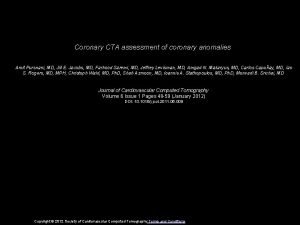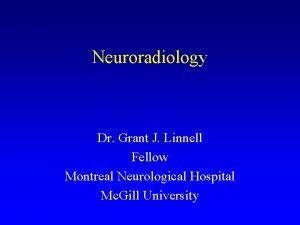XRAY COMPUTED TOMOGRAPHY FOR THE CHARACTERIZATON OF THE

- Slides: 1

X-RAY COMPUTED TOMOGRAPHY FOR THE CHARACTERIZATON OF THE CELLULAR STRUCTURE OF FOAMED CEMENT LILLIAN BEI JIA LAU Mentor: Jamie V. Clark PROJECT TECHNIQUE Faculty Advisor: Professor David A. Lange DEPARTMENT OF CIVIL AND ENVIRONMENTAL ENGINEERING, UNIVERSITY OF ILLINOIS BACKGROUND o Possible methods for determining thresholding values in CT data o Understanding cement pore structure is important. URBANA-CHAMPAIGN in improving the durability of concrete. o However, current methods that include: • Scanning Electron Microscopy (SEM) • Transmission Electron Microscopy (TEM) • Mercury Intrusion Porosimetry (MIP) yield incomplete results and require extensive sample preparation. o X-Ray CT is a non-invasive imaging technique which requires minimal sample preparation. o Specific greyscale values collected from the CT data are used as thresholds to determine the percentage of pores and cement. o The current method of visually segmenting pores from the cement to obtain the greyscale threshold value may be inaccurate due to its subjectivity. o We applied six different methods of thresholding the greyscale values of foamed cement of four different densities. segmentation were identified: • Otsu’s method • MATLAB programming • • • Gaussian deconvolution • Visual segmentation Backtracking (control) 300 voxel sample sizing o The 16 -bit images from the CT scan of four different densities of foamed cement were converted to 8 -bit images with greyscale values ranging from 0 (black) to 255 (white) in AMIRA. o The different threshold values of each method was applied the foamed cement to reconstruct its density and its 3 D structure using the Fig. 3: 0. 6 Density resultant material statistics 16 -bit image in AMIRA software. Fig. 4: 0. 6 Density 8 -bit image RESULTS o The different thresholding methods produced mixed results. Fig. 1: Sample preparation PROBLEM STATEMENT What is the best method Pores to determine thresholding values in foam cement characterization? Fig. 5: 0. 3 Density 3 D Model (Gaussian), Poorest Threshold value=16 Fig. 6: 0. 6 Density 3 D Model (Gaussian), Best Cement Fig. 2: X-Ray Intensity vs. Greyscale Values for 0. 5 Density Foam Cement using Gaussian Deconvolution Fig. 10: Graphs of Densities vs Thresholding Methods o The Gaussian curves also did not perfectly fit due to the non-normal distribution of the two phases. o To reduce future errors, more samples should be taken to make up for the small sample size. CONCLUSION o The study was unable to conclusively determine one best method to threshold foam cement X-Ray CT data. o However, the variability of the more objective thresholding methods showed that the best way to consistently analyze the CT data of the foamed cement is visual segmentation. o Further studies have to be carried out using a volume of 300 voxels in AMIRA to improve accuracy. REFERENCES • Bossa, N. , Chaurand, P. , Vicente, J. , Borshneck, D. , Levard. , C. , Aguerre-Chariol, O. , Rose. , J. “Microand Nano-X-ray computed tomography: A step forward in the characterization of the pore network of a leached cement paste. ” Cement and Cocrete Research 67, 2017. • Nambiar, E. K. K. , Ramamurthy, K. “Air void characterization of foam concrete”. Cement and Concrete Research 37, 2007. • Zhang, M. , He, Y. , Ye. , G. , Lange, D. A. , Bruegel. , K. “Computational investigation on mass diffusivity in Portland cement paste based on X-ray computed microtomography (µCT) image. ” Construction and Building Materials 27, 2012. Fig. 7: 0. 4 Density 3 D Model (300 Voxels), Best Fig. 8: 0. 5 Density 3 D Model (300 Voxels), Best Table 1: Comparison of accuracy of different thresholding methods DISCUSSION o At 500 voxels, the method that yielded the most consistent results was the visual method. o The thresholding methods that gave the best densities yielded models with ‘cement’ inside the pore space. o The sample size was reduced to 300 voxels, which resulted in the most accurate reproduction of the densities. o These conflicting results could be due to the small sample size and noise Fig. 9: 0. 6 Density 3 D Model (Gaussian), Best

